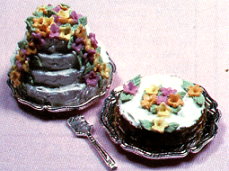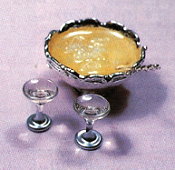WEDDING WISHES
The bride and groom cakes and a sparkling punch are as traditional as the ceremony itself
JUNE 1985
by Mary Eccher page 1 of 3
The lore of the wedding cake is fascinating. The first types made in this country, were often known as
"great cakes," and were variations of standard "spice" cakes, dating far back into British history. Made with whatever dried fruits were available in the household at the time and laced with brandy or liquor. They were meant to last for months --- in some cases, years --- and provident young women, auguring the future, sometimes baked their cakes long before they'd found a bridegroom, thus providing evidence of their culinary accomplistments.
Such long-lasting cakes were typical at American weddings for generations. In 19th century New England, mixtures of nuts, fruits and spices often incorporated molasses --- the result was called "black cake." Whatever the name, such cakes were the object of various superstitions. Often pieces were sent to invited quests who could not be present. Unmarried girls hid a slice under their pillows to stimulate dreams of the man they hoped to wed. Less frequent is the ceremony of passing small portions of the wedding cake through the wedding ring. The bride held the ring between the finger and the thumb of her right hand, through which the groom passed each portion of the cake nine times. He then delivered these in succession to the bridesmaids, who sealed them up carefully and regarded them as amulets of inestimable value. If the fair maiden deposited this amulet in the foot of her left stocking, and placed it under a pillow on going to rest, she would surely dream of the man destined by fate to be her partner for life.
Until the 19th century the fashion of crumbling the cake over the heads of the bride and groom was a fixed part of the bridal revelry that led to the present tossing of handfuls of rice. In 18th century New England, when the bride returned from the church to her father's house for the reception, as she crossed the threshold, a plate containing a few spare pieces of the ceremonial cake would be tossed out an upper story window to test the portents for happiness or sorrow. A plate of cake that broke on impact was a sign of an unblemished future, whereas one that remained whole was promise of rough going.


Old Photos
While these playful customs prevailed, the wedding cake remained a dark and pungent loaf of fruit and nuts. The production of more finely ground flour and the development of baking powder and baking soda led to the introduction in the years before the Civil War of the white wedding cake. To be known, in time, as the bride's cake and sometimes as lacy and elegant as a bridal gown or just as often extremely simple.
The tradition of the groom's cake (usually a steamed fruitcake) is said to have begun in 1847 in Chicago, when a son of President Grant was married in "one of the most brilliant weddings ever witnessed in the West." Newspapers reported both a "bride's cake, decorated with natural flowers," and at the other end of a long table a "groom's cake."



Handcrafted Collectible Dollhouse Scale Miniature Foods, Beverages and Accessories
IGMA ARTISAN
NAME ACADEMY of HONOR AWARD MEMBER
Member of CIMTA
I will celebrate your life for the rest of mine....